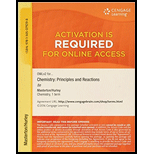
Interpretation:
The volume of the given sample should be calculated.
Concept introduction:
Number of moles is equal to the ratio of given mass to the molar mass.
The mathematical expression is given by:
Number of moles =
Molarity is defined as the ratio of number of moles of solute to the volume of the solution in liters.
The mathematical expression is given by:
Molarity =
A solution of salt of metal when reacts with other solution to give products, the formula which is used to find the volume of either solution is given by:
Where, M1 and M2 are molarity of the solution
V1 and V2 are volume of the solution
Density is defined as the ratio of mass to the volume.
Density =
Want to see the full answer?
Check out a sample textbook solution
Chapter 4 Solutions
CHEMISTRY:PRIN.+REACTIONS-OWLV2 ACCESS
- What volume of 0.250 M HCI is required to neutralize each of the following solutions? a. 25.0 mL of 0.103 M sodium hydroxide, NaOH b. 50.0 mL of 0.00501 M calcium hydroxide, Ca(OH)2 c. 20.0 mL of 0.226 M ammonia, NH3 d. 15.0 mL of 0.0991 M potassium hydroxide, KOHarrow_forwardChlorisondamine chloride (C14H20Cl6N2) is a drug used in the treatment of hypertension. A 1.28-g sample of a medication containing the drug was treated to destroy the organic material and to release all the chlorine as chloride ion. When the filtered solution containing chloride ion was treated with an excess of silver nitrate, 0.104 g silver chloride was recovered. Calculate the mass percent of chlorisondamine chloride in the medication, assuming the drug is the only source of chloride.arrow_forwardWrite a balanced equation for the reaction of hydroiodic acid, HI, with calcium hydroxide, Ca(OH)2. Then, write the balanced complete ionic equation and the net ionic equation for this neutralization reaction.arrow_forward
- Potassium hydrogen phthalate, KHC8H4O4, is used to standardize solutions of bases. The acidic anion reacts with bases according to this net ionic equation: A 0.902-g sample of potassium hydrogen phthalate requires 26.45 mL NaOH to react; determine the molarity of the NaOH.arrow_forward1. Sometimes a reaction can fall in more than one category. Into what category (or categories) does the reaction of Ba(OH)2(aq) + H+PO4(aq) fit? acid-base and oxidation-reduction oxidation-reduction acid-base and precipitation precipitationarrow_forwardWhen 10. L of water is added to 3.0 L of 6.0 M H2SO4, what is the molarity of the resulting solution? Assume the volumes are additive.arrow_forward
- Vitamin C is ascorbic acid, HC6H7O6, which can be titrated with a strong base. HC6H7O6(aq) + NaOH(aq) NaC6H7O6(aq) + H2O() A student dissolved a 500.0-mg vitamin C tablet in 200.0 mL water and then titrated it with 0.1250-M NaOH. It required 21.30 mL of the base to reach the equivalence point. Calculate the mass percentage of the tablet that is impurity.arrow_forwardYou can dissolve an aluminum soft drink can in an aqueous base such as potassium hydroxide. 2 Al(s) + 2 KOH(aq) + 6 H2O(l) 2 KAI(OH)4(aq) + 3 H2(g) If you place 2.05 g of aluminum in a beaker with 185 mL of 1.35 M KOH, will any aluminum remain? What mass of KAI(OH)4 is produced?arrow_forwardLactic acid, C3H6O3 is the acid present in sour milk. A 0.100-g sample of pure lactic acid requires 12.95 mL of 0.0857 M sodium hydroxide for complete reaction. How many moles of hydroxide ion are required to neutralize one mole of lactic acid?arrow_forward
- Consider the following generic equation OH(aq)+HB(aq) B(aq)+H2OFor which of the following pairs would this be the correct prototype equation for the acid-base reaction in solution? If it is not correct, write the proper equation for the acid-base reaction between the pair. (a) hydrochloric acid and pyridine, C5H5N (b) sulfuric acid and rubidium hydroxide (c) potassium hydroxide and hydrofluoric acid (d) ammonia and hydriodic acid (e) strontium hydroxide and hydrocyanic acidarrow_forwardTwenty-five mL of a 0.388 M solution of Na2SO4 is mixed with 35.3 mL of 0.229 M Na2SO4. What is the molarity of the resulting solution? Assume that the volumes are additive.arrow_forwardConsider the following generic equation: H+(aq)+ B(aq)HB(aq)For which of the following pairs would this be the correct prototype equation for the acid-base reaction in solution? If it is not correct, write the proper equation for the acid-base reaction between the pair. (a) nitric acid and calcium hydroxide (b) hydrochloric acid and CH3NH2 (c) hydrobromic acid and aqueous ammonia (d) perchloric acid and barium hydroxide (e) sodium hydroxide and nitrous acidarrow_forward
 Chemistry: Principles and PracticeChemistryISBN:9780534420123Author:Daniel L. Reger, Scott R. Goode, David W. Ball, Edward MercerPublisher:Cengage Learning
Chemistry: Principles and PracticeChemistryISBN:9780534420123Author:Daniel L. Reger, Scott R. Goode, David W. Ball, Edward MercerPublisher:Cengage Learning Introductory Chemistry: A FoundationChemistryISBN:9781337399425Author:Steven S. Zumdahl, Donald J. DeCostePublisher:Cengage Learning
Introductory Chemistry: A FoundationChemistryISBN:9781337399425Author:Steven S. Zumdahl, Donald J. DeCostePublisher:Cengage Learning Chemistry: Principles and ReactionsChemistryISBN:9781305079373Author:William L. Masterton, Cecile N. HurleyPublisher:Cengage Learning
Chemistry: Principles and ReactionsChemistryISBN:9781305079373Author:William L. Masterton, Cecile N. HurleyPublisher:Cengage Learning Chemistry & Chemical ReactivityChemistryISBN:9781337399074Author:John C. Kotz, Paul M. Treichel, John Townsend, David TreichelPublisher:Cengage Learning
Chemistry & Chemical ReactivityChemistryISBN:9781337399074Author:John C. Kotz, Paul M. Treichel, John Townsend, David TreichelPublisher:Cengage Learning Chemistry & Chemical ReactivityChemistryISBN:9781133949640Author:John C. Kotz, Paul M. Treichel, John Townsend, David TreichelPublisher:Cengage Learning
Chemistry & Chemical ReactivityChemistryISBN:9781133949640Author:John C. Kotz, Paul M. Treichel, John Townsend, David TreichelPublisher:Cengage Learning ChemistryChemistryISBN:9781305957404Author:Steven S. Zumdahl, Susan A. Zumdahl, Donald J. DeCostePublisher:Cengage Learning
ChemistryChemistryISBN:9781305957404Author:Steven S. Zumdahl, Susan A. Zumdahl, Donald J. DeCostePublisher:Cengage Learning





